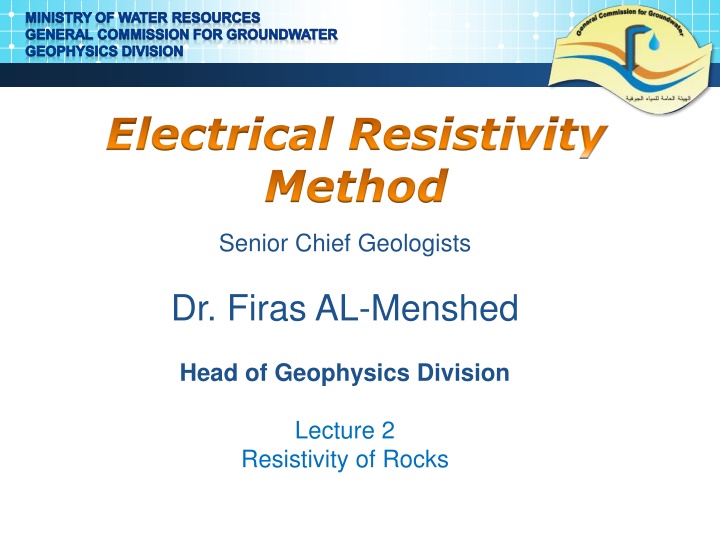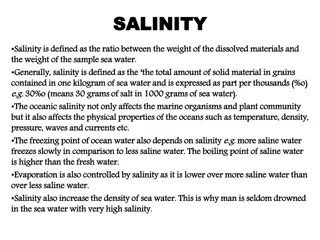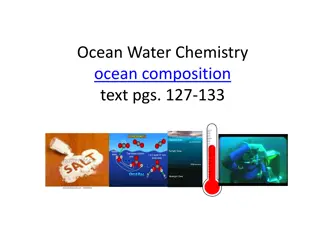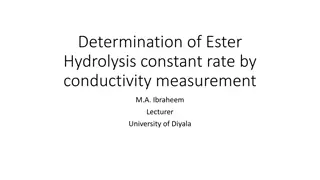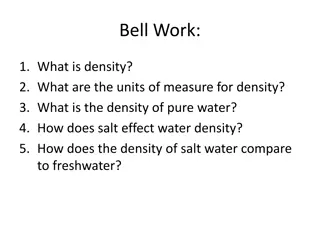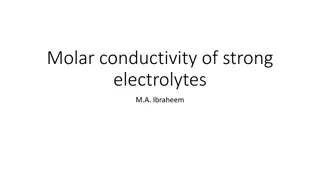Conductivity, Salinity, and TDS in Water
Conductivity measures water's ability to conduct electricity based on ionic strength, while salinity indicates total dissolved salts concentration. Total Dissolved Solids (TDS) combine ion particles smaller than 2 microns. Explore units of measure and an interesting fact about density and salt levels impacting ocean circulation.
Download Presentation

Please find below an Image/Link to download the presentation.
The content on the website is provided AS IS for your information and personal use only. It may not be sold, licensed, or shared on other websites without obtaining consent from the author.If you encounter any issues during the download, it is possible that the publisher has removed the file from their server.
You are allowed to download the files provided on this website for personal or commercial use, subject to the condition that they are used lawfully. All files are the property of their respective owners.
The content on the website is provided AS IS for your information and personal use only. It may not be sold, licensed, or shared on other websites without obtaining consent from the author.
E N D
Presentation Transcript
MINISTRY OF WATER RESOURCES GENERAL COMMISSION FOR GROUNDWATER GEOPHYSICS DIVISION Electrical Resistivity Method Senior Chief Geologists Dr. Firas AL-Menshed Head of Geophysics Division Lecture 2 Resistivity of Rocks
Resistivity of Rocks Resistivity is the physical property which determine the aptitude of this material to be opposed to the passage of the electrical current. The most common soil and rock forming minerals are insulators in the dry state, and thus the amount of wet and the properties of the water largely determine the resistivity. Therefore, in the different models that have been used for describing resistivity of soils and rocks, there has been two categories depending on if the soil has clay content or not.
Electronic Conductance The current flows by displacement of electrons known as electronic conductance or metallic conductance because it is a similar conductance to that of metals. Rocks with metallic content may have significant conduction through the crystalline structure. The presence of clay minerals, since these minerals bind water molecules and ions and thereby facilitate electrical conduction. Clay particles coating the surfaces of the larger mineral particles may have a dominating effect on the bulk resistivity of a predominantly coarse grained soil, creating so called surface conduction.
Electrolytic Conductance The current is carried by ions. The electrical resistivity of rocks bearing water is controlled mainly by the water which they contain. Electrical conduction in geological materials is mainly electrolytic. The most common soil and rock forming minerals are insulators in the dry state, and thus the amount of wet and the properties of the water largely determine the resistivity. The electric current is normally takes the easier way to flow throw, therefore it takes the fluid in the rock to pass.
The resistivity of natural soils and rocks varies within very wide ranges as in table, and this difference in resistivity is the foundation of resistivity survey Earth Material Resistivity range ( m) Sedimentary Rocks Shale Sandstone Conglomerate Limestone Dolomite 10 - 103 1 - 108 103 - 104 50 - 107 102 - 104 Unconsolidated sediments Gravel Sand Clay Marl 102 - 104 102 - 104 1 - 102 1 - 102 Ground water Fresh water Brackish water Sea water Super saline brine 0.1 - 103 0.3 - 1 0.2 0.05 - 0.2
Factors effecting Resistivity The electrical resistivity of rocks decrease if: 1. The quantity of dissolved salts (salinity) increase. 2. The quantity of water (saturation) increase. 3. The quantity of conductive minerals increase. 4. The porosity (in wet conditions) and permeability increase. 5. The temperature increase
Dissolved Salts (Salinity) Salinity refers to the total concentration of all dissolved salts in water. Since salts form ionic particles when dissolved, salinity is a strong component of electrolytic conductivity. Resistivity Resistivity is inversely proportional to salinity. Salinity
Porosity Porosity is defined as the ratio of the volume of the voids or pore space divided by the total volume. Grain Pore Porosity = (Volume of pore) / (Volume of Rock)
Classification of Porosity Effective Porosity Non Effective Porosity (Inter connection between pores (No Inter connection between pores ( (
Types of Porosity poorly sorted sand Well sorted sand Fractures Cavities
Resistivity Resistivity in dry conditions is directly proportional to Porosity. Porosity Resistivity Resistivity in wet conditions is inversely proportional to Porosity. Porosity
Relation between Resistivity and Porosity Archie s law a a = = m w S w S m n n : resistivity of rock w: resistivity of the fluid (water) : porosity S: saturation in water a: factor depends on the lithology (varies between 0.6 and 2) m: cementation factor (depend s on the pores shape, of the compaction and varies between 1.3 for unconsolidated sands to 2.2 for cemented limestone). n: about 2 for majority of the formation with normal porosities containing water between 20 and 100%. Hint: Archie s law is not valid if clay is present because it has ionic exchange capacity, therefore the conductivity of the pore fluid largely increase
Permeability Permeability is the property of rocks that is an indication of the ability for fluids (gas or liquid) to flow through rocks. High permeability will allow fluids to move rapidly through rocks. There is no direct relationship between resistivity and permeability. Rock permeability depends on: 1. Shape and size of grains. 2. Packing index. 3. Cementation. 4. Matrix materials.
Temperature At moderate temperatures, 0-200 C, resistivity of aqueous solutions decreases with increasing temperature. The reason is increasing mobility of the ions caused by a decrease in the viscosity of the water. Dakhnov (1962) has described this relationship: = 0 w w + 1 ( ) T T 0 w0is the resistivity of the fluid at T0, T0is the reference temperature , is the temperature co efficient of resistivity. 0.023 C for T0 = 23 C, and 0.025 C for T0 = 0 C.
For metals or conductors, when the temperature increases and the resistivity of the metal increases and thus current flow in the metal is decreased. They have a positive temperature co efficient. The value is positive. For temperature conductivity increased. It means that the resistivity of the material is decreased and so the current flow is semiconductors they have a negative temperature co efficient. So the value of temperature co resistivity, is negative. semiconductors, is of when the the is increased the material increased. For efficient of
